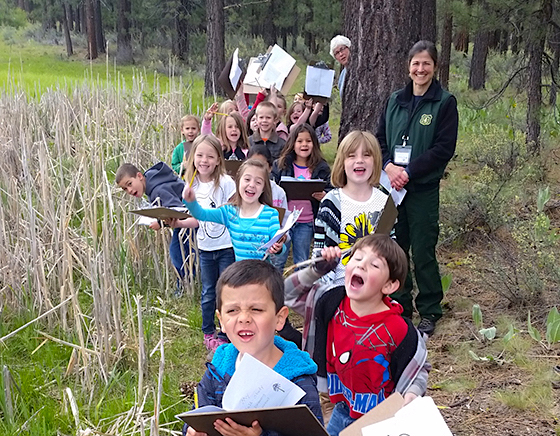Land trusts and schools make ideal allies, uniting around a shared goal of bringing kids outdoors.

Feather River Land Trust in California enables K-12 teachers to “Teach from the Land” | Photo courtesy of Feather River Land Trust
Across the country, land trusts are focusing on the next generation, providing land, programs, support and funding to enrich the educational experiences and lives of youth in their communities. This is an example of what the Land Trust Alliance calls “community conservation.”
But community conservation goes beyond the classroom. It’s about food and hunger, and connecting people to agriculture. It’s about veterans using land and water to rejuvenate the mind, body and spirit. It’s about providing our elders access to the outdoors, and so much more.
So how do we define community conservation?
Community conservation is about making land conservation relevant by land trusts engaging all people in their communities who have not traditionally been served by, engaged in, or moved by land conservation.
How the Land Trust Alliance Supports Community Conservation
We showcase groundbreaking community conservation projects, so land trusts can inform and inspire each other. We’re also providing cutting-edge training — from workshops and retreats to webinars, guides and videos. And we support select pilot projects with the potential to scale nationally.
Rob Aldrich, director of community conservation at the Alliance, shares his favorite community conservation stories below that highlight partnerships between land trusts and schools across the nation.
Bringing Food into the Classroom
Oregon Sustainable Agriculture Land Trust in partnership with Portland Groundworks has transformed a vacant property with the help of students and teachers at King School and da Vinci Arts Middle School. Students study the environmental cleanup at the property, along with the complex history of Northeast Portland. Additionally, students learn where their food comes from.
DaVinci teacher Christie King built her spring lesson plan around the lot and the neighborhood’s evolution. Students participated in walking tours, heard from guest speakers who grew up in the area, and created comic books about events in the community’s development. Volunteers and students have created paths, built two raised beds and a trellis, and planted kale, lettuce, onions, broccoli, berries and an assortment of flowers and an outdoor classroom.
Creating a Culture of Caring

Educational programs of Little Traverse Conservancy in Michigan reach 4,500 kids each year | Photo courtesy of Little Travers Conservancy
For nearly 30 years, Little Traverse Conservancy in Michigan has offered programs and activities on their lands, as well as in the classroom, to foster a greater understanding, appreciation and enjoyment of the natural environment.
Annual reach of their program averages more than 4,500 children from over 270 school groups to help them appreciate nature and learn about the outdoors in the outdoors. In addition to the students, hundreds of parents and teachers attend and assist with the activities.
“I find it essential in today’s society to get our kids outdoors. Many of my students do not have opportunities nor take the opportunity to appreciate nature. By building in time with LTC, I not only am able to meet several state standards, but allow my students to discover and learn in a way they may have never imagined,” says Christie Meyer, teacher at Concord Academy Boyne (partner with Little Traverse Conservancy).
Mentoring Urban Youth
Lookout Mountain Conservancy initiated a partnership with a local high school facing the lowest graduation rates in Chattanooga, Tennessee. Leadership Interns (11 to 18 high school students per year) are hired to work with land trust staff on a weekly basis, all school breaks, and full-time during the summer, participate in leadership training and the transformation of a property into an urban nature-based park and community oasis.
The land trust uses conservation as a tool to change lives by providing academic and life-skills mentoring; community-job-shadowing and enrichment activities; a sense of place in the out-of-doors, including growing and cooking food, trail design and maintenance, and habitat restoration; and a community of support. Students who decide to enroll in college or technical schools are provided mentoring support and summer employment. As a result of this program, 100% of participating seniors graduated from high school, surpassing the school’s overall 63% graduation rate.
Transforming Land to Become “Learning Landscapes”
“Learning Landscapes” is a three-pronged effort by Feather River Land Trust in California to:
- Conserve and steward outdoor classrooms on campuses and natural areas next to public schools, making it easy for teachers to bring students outside to learn, play, and steward the land;
- Improve areas on, or near, school campuses by installing trails, signs, and seating areas on campuses and adjacent lands to create ideal outdoor learning environments;
- Support K-12 teachers to “Teach from the Land” and lead their students in hands-on restoration and stewardship projects.
Student land stewards are also involved in special projects. “Learning Landscapes” affects approximately 2,900 schoolchildren per year in grades K-12 from seven communities within three counties. Each school year, every child in every school gets outside once a week.
Interested in more stories? Visit the Land Trust Alliance’s website here or contact Rob Aldrich at 202-800-2225 or raldrich@lta.org for more information.
The Land Trust Alliance works with more than 1,000 land trusts across the country that are conserving millions of acres of land in local communities every year. The Alliance supports these land trusts through training, resources, and advocacy to help accelerate land conservation across the country.
